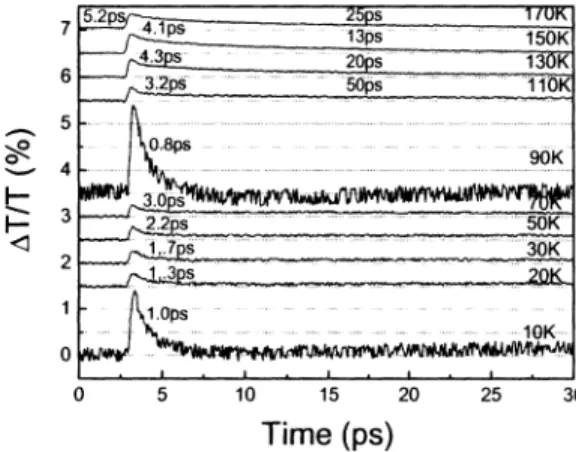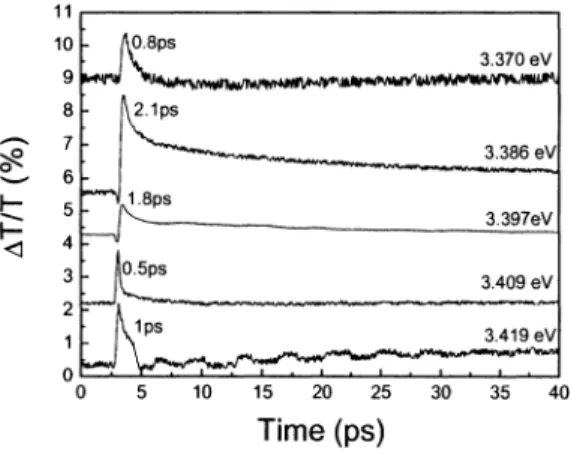2005 Conference on Lasers & Electro-Optics (CLEO)
CMII5
Observations
of Exciton
Density
of State Variations in
a
ZnO
Thin
Film
with fs
Pump-probe
Experiments
Cheng-Yen Chen, Yen-Cheng Lu, Hsiang-Chen Wang, Fang-Yi Jen,and C. C.Yang GraiduateInstitute ofElectro-Opticwal Engineering (and Departmentof ElectricalEngineering,
National TatiwanUniversity,1, RooseveltRoad, Sec. 4,Taiipei,Taiwan, R. 0. C.
Bao-ping ZhangandYusaburoSegawa
Photoday,namics ResearchCenter,TheInstitute ofPhysical aind Chemicail Research(RIKEN),Sendai, Jalpan Abstract: Variations ofexciton densityofstatearoundthe levelsofdonor-bound and freeexcitons in a ZnO thin film are observed with temperature- and photon energy-dependent degenerate fs
pump-probespectroscopyforexploringitsexcitondynamics.
2005Optical SocietyofAmerica
OCIScodes:(320.7150) Ultrafast spectroscopy;(160.6000) Semiconductors, including MQW
1. Introduction
The radiative recombination ofan electron and a hole in an exciton is more efficient than those offree motion.
Therefore,fordeveloping efficientlight-emitting devices, compound materialsoflargerexcitonbindingenergiesare more attractive. Because of thelargeexcitonbindingenergy(60meV versus30 meVinGaN)inZnO,ithasattracted quitemuch attentionincrystal growthandoptical characterization, includingultrafast carrierdynamics [1-4].Insuch acompound,excitons existin several forms, includingdonor-boundexciton(D°X) and freeexciton(FX). Since the
high photon emission efficiency ofsuch a compound relies on exciton dynamics, the understandings ofexciton
densityofstatedistribution and hence ultrafastexciton dynamicsarecruciallyimportant. In this paper,weobserve the variation ofexciton density ofstate and explorethe excitondynamics ina ZnO thin film with fs pump-probe spectroscopy. In particular, we perform temperature- and photon energy-dependentmeasurements around the D°X and FX levels. Exciton flow amongthese levelscanbeevaluated.
2.Sample Preparationand ExperimentalMethods
Thesamplewasgrowninan MOCVDreactor onsapphire substrate. Thegrowthtemperaturewas450'Cfor 60min
[5].Thegrowthpressurewas6Torr.Thein-planeorientation could be controlled with thegrowthtemperature,which could leadtodifferentgrowth modes at the initial stage ofgrowth. With the aforementionedgrowth condition,
300
in-plane twist was obtained in the used sample. The second-harmonic generation through a BBO crystal ofa fs
Ti:sapphire laser with 100 fs inpulse width and 76 MHzinpulserepetition frequencywasusedfor the degenerate
pump-probeexperiments. Thesecond-harmonicpulse widthwasabout 150fsec. The pump powerwasmaintainedat about 16mWand theprobepowerwas onetenthof the pump power.
3. Pump-probeExperimentalResults
Temperaturedependent photoluminescence(PL) spectra ofthesampleareshown in Fig. 1. Here, one can see that the PLpeakof increasing width red shiftswith temperature.At 10 K,onlyone majorpeakof
D0X
(at 3.365 eV) can be seen.However,at20 Kasmallhumparound 3.376eV,correspondingtotheemergenceofFX,canbeobserved.Thishump becomesmoreprominent and dominantinspectrabeyond80 K. Itred
shifts,
particularly significantly beyond 80K,to3.293 eVat300K[6]. Beyond80K,twopeaksat3.307 and 3.230 eV (at 80 K),corresponding to the DAP(donor-acceptorpair) and DAP-LO (LOphonon-assisted DAP), respectively, canbe identified. It isnoted that the
D°X feature position does not vary significantly with temperature until it disappears around 100 K. In this temperature range, the FX feature positionis almostfixed. Thespectral peak energies of D°X and FX at 10 K are usedfor thepump-probe experiments.
Fig. 2 showsthedifferentialtransmissionprofiles atvarioustemperatureswhenthe pump-probe photon energy is3.366eV, correspondingtothe D°X state at10 K. Here, one can seethatAT/Tissignificantly strong at 10 and 90 K. Usually the variation magnitude of AT/T represents the band filling effect. Hence, the large magnitudes in
differential transmission at 10 and 90 K can be interpreted as high densities of state at the pump-probe photon energies at these two temperatures. As mentioned, this photon energy corresponds to D°X state at 10 K. It
approximatelycoincides with thestateofFX at90K,asshown inFig. 1. Therelatively higher densities of states at theD°X andFXleadtothe strongerpump-probe responses. The two-stage decay time constants of these pump-probe
profiles are labeledin the figure. The fast decay inthe early stage, ranging from 0.8 to 4.3 ps,
describes
exciton thermalizationthrough scattering. The relatively slower decay, in the time range of a few tens ps, beyond 100 K621 I
2005Conference onLasers& Electro-Optics (CLEO)
CMII5
explains the mixed process ofexciton recombination and mild relaxation into the FXstate. The slightly increasing
trends in the later stage when temperatureis lower than 100 K(withoutlabelingthe decay timeconstants) may be duetothe in-flow ofexcitons intothecorrespondingstatesof eitherD°XorFXlevel.
Fig. 3shows the differential transmissionprofiles atvarious temperatures when thepump-probe photonenergy is 3.376 eV, correspondingto the FX state at 10 K. Basically, themagnitude of AT/Tdecreases with temperature,
particularly significantly beyond 100 K. The decreasing trend is due to the
increasing
gap between the fixed pump-probephotonenergy(3.376eV) and thedecreasingFXlevelastemperatureincreases.AsshowninFig. 1,this gap becomes particularly significant beyond 100 K. Hence, the differential transmission level decreases faster beyond 100 K.Thedecaytime constantsof the early-stagefastdecay (inthe range ofacouple ps)againrefertothe process of exciton/carrier thermalization. The time constants labeled for the slower seconddecay
stagemainly
describe the relaxation ofexcitons/carriersintotheFXand
D°X
states.Fig. 4 shows the AT/T profiles ofseveral pump-probephoton energies at 10 K. The first curve from the top (3.370 eV)corresponds tothephoton energybetween thestatesofD°Xand FX. Therest arebetween the FX level andthe conduction bandedge. Thebottomcurvefor 3.419eV maybe quiteclosetothedonorlevel
(bound electron),
which is estimated tobe at 3.425 eV. Again, the fast
decay
here is related to exciton/carrier thermalization. The slower decay involves exciton relaxation intothe D°X level. In this process, for thepump-probe
photon
energies closeto either the FX ordonorlevel, partof carriers may flow backintotheprobe
level. This mechanismexplains
theslightlyincreasingtrends in the topcurveand thetwobottomcurves.The oscillation inthecurveof 3.419eVcan
be dueto acouplingprocess betweentwolevels. It deserves further
investigation.
1.10 3A-5 - m 3 280K 3.10 3.532-.533033 .034 6 3.2ps _ psV110K 25.0 ... R.43e E2 13
1
lOps 0 3.15 10 15 20 25 30Time
(ps)
Fig.2Differential transmission profiles at varioustemperatureswhen the pump-probe photon energy is 3.366 eV, corresponding to theD5Xstate at105K.
2
2005Conference on Lasers &Electro-Optics(CLEO)
CMII5
H "IZ ,[_ Time(ps)Fig. 3 Differential transmissionprofilesatvanrous temperatures when thepump-probe photonenergy is 3.376eV,correspondingtotheFXstateat 10 K.
11
10i0.8ps
3.370
eV 9 _ 8- 02.1ps 0~ 6 -1 4 < - - - ~~~~~~~3.397ev 3v.5ps
3.409 ev 2 -0 5 10 15 20 25 30 35 40Time
(ps)
Fig.4Differential transmissionprofilesatseveralphotonenergies when the temperature is10 K.
4.Conclusions
Insummary, we haveinvestigatedthe variationsofexcitondensity of statein aZnO thin film around the D°X and FX levels with temperature- and photonenergy-dependent fs pump-probemeasurements. The processes ofexciton thermalization and relaxation among the levels of FX, D°X, and donorstate wereobserved.
Acknowledgement:
This research was supported by National Science Council, The Republic of China, under the grant of NSC
92-2210-M-002-006and NSC92-2215-E-002-010, andbyUS Air Forceunder thecontractAOARD-04-4026. References:
1. A.Zeuner, H.Alves, D. M. Hofmann, B. K. Meyer, M. Heuken,J.
Biasing,
and A. Krost, Appl. Phys. Lett. 80, 2078-2080(2002).2. A.Tsukazaki,A.Ohtomo, M. Kawasaki, T. Makino,C. H.Chia,Y.Segawa, and H.Koinuma,Appl. Phys. Lett. 84, 3858-3860(2004).
3. A.Yamamoto,T.Kido,T.Goto,Y.Chen,T.Yao,and A.Kasuya,
AppI.
Phys.Lett.75, 469-471 (1999).4. T. Tokizaki, H. Sakai, A. Nakamura, Y. Manabe, S. Hayashi, and T. Mitsuyu, Semicond. Sci. Technol. 10, 1253-1256(1995).
5. B. P.Zhang, K. Wakatsuki,N.T. Binh,N. Usami,Y.Segawa,ThinSolid Films449, 12-19 (2004).
6. S.F.Chichibu,A.Tsukazaki,M. Kawasaki, K. Tamura, Y,Segawa, T. Sota, and H.
Koinuma,
Appl. Phys. Lett. 80, 5860-5862(2002).3

